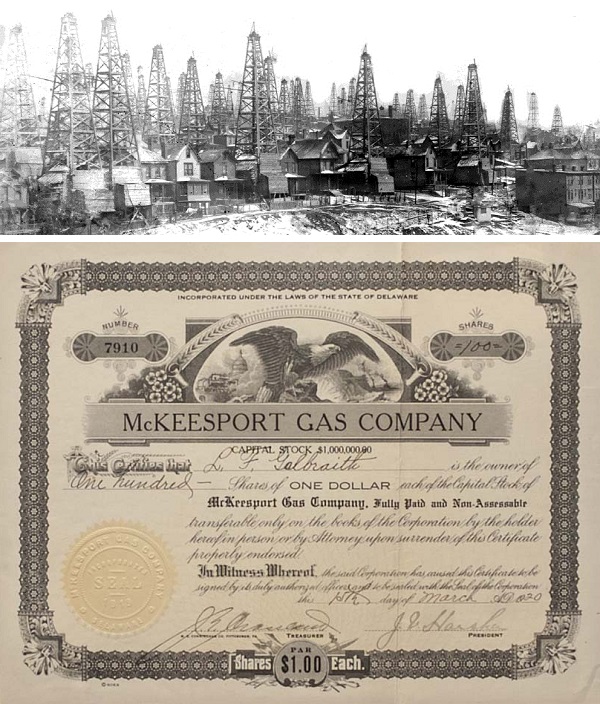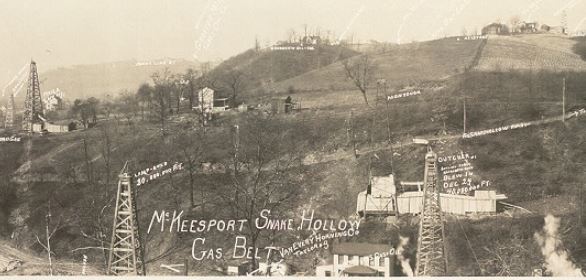McKeesport Gas Company
The “Snake Hollow Gusher” brought Pittsburgh a $35 million natural gas drilling boom — and bust.
“Rarely, a community sees its pulse quicken with a get-rich-quick beat, feels the boom fever strike, suffers the chill of disillusion when the ‘El Dorado’ fades out and then recovers,” noted the Pittsburgh Press in 1934, decades after the excitement began.
“But this is what happened at the McKeesport gas field, scene of the Pittsburgh district’s biggest boom and loudest crash,” the newspaper added. McKeesport Gas Company was among the many petroleum company casualties.

Pennsylvania’s natural gas fields attracted investors to many ambitious drilling ventures, including McKeesport Gas Company.
Following the first U.S. oil discovery at Titusville, Pennsylvania, in late August 1859, natural gas development began in western Pennsylvania.
With new oilfields came discoveries of large volumes of gas suited for illumination, heating, and manufacturing. Natural gas began to be widely used after two brothers drilled into a massive gas field gas field on November 3, 1878.
The Haymaker brothers’ discovery brought the new energy resource to Pittsburgh factories and steel mills. By the late 1880s, Pittsburgh skies cleared for the first time in decades as mills and factories burned natural gas instead of coal.
Learn more about the once famous 1878 Haymaker gas well in Natural Gas is King in Pittsburgh.
Biggest Boom
For investors in 1919, the region’s natural gas history seemed to be repeating itself. McKeesport Gas Company was one of about 300 petroleum companies that sprang up within six months of an August 30, 1919, discovery — a runaway natural gas well near McKeesport.
The “Snake Hollow Gusher” between the Monongahela and Youghiogheny rivers, blew in at more than 60 million cubic feet of natural gas a day. The headline-making gas well, drilled by S.J. Brendel and David Foster, prompted a frenzy that saw $35 million dollars invested during the boom’s seven-month lifespan.
McKeesport Gas Company incorporated on December 5, 1919, and two weeks later enticed investors with advertisements in the Pittsburgh Press and the Gazette Times newspapers. “Over 500 Acres of Leases in the Heart of the McKeesport Gas Fields,” proclaimed one newspaper ad, offering stock at $1.25 a share.
“Many residents signed leases for drilling on their land,” noted another local reporter. “They bought and sold gas company stock on street corners and in barbershops transformed into brokerage houses in anticipation of fortunes to be made.”
Then the natural gas reserves ran out.
Loudest Crash
By the beginning of 1921, McKeesport natural gas production was falling in about 180 producing wells — and more than 440 unsuccessful wells had been drilled. The field would be reported as, “the scene of the Pittsburgh district’s biggest boom and loudest crash.”
Of the estimated $35 million sunk into the nine square mile area of the boom, only about $3 million came out.

A detail from “McKeesport, Snake Hollow, Gas Belt,” a circa 1920 panoramic image by Hagerty & Griffey. Photo courtesy Library of Congress.
A circa 1920 panoramic photograph at the Library of Congress captured the drilling boom at the McKeesport, Snake Hollow, Gas Belt, by Hagerty & Griffey.
McKeesport Gas Company likely drilled a few of the boom’s hundreds of dry holes and with funds exhausted, disappeared into petroleum history. Fifteen years later, McKeesport Mayor George H. Lysle explained to a Pittsburgh newspaper reporter how the town survived the “seven-month wonder” natural gas boom:
“Other boom towns,” he said, “were built merely on the strength of the wealth that was to pour from their wells or mines. But McKeesport and vicinity was established before the boom came.”
When the drilling ended, Lysle added, “people still had their jobs in the mills and stores, the permanent population remained, and the natural resources of the district, except for gas, were still as great as ever. We were still a great industrial community.”
Advances in the science of petroleum geology and improved production technologies have brought surer results than the Snake Hollow Gusher. As early as 2010, the region’s gas boom — the Marcellus Shale — extended across western Pennsylvania into other Appalachian Basin states.
Because of the region’s history, McKeesport Gas Company stock certificates are considered collectible; the stories of other exploration companies trying to join petroleum booms (and avoid busts) can be found in the updated research in Is my Old Oil Stock worth Anything?
_______________________
Recommended Reading: McKeesport – Images of America: Pennsylvania (2007); Western Pennsylvania’s Oil Heritage
(2008); The Extraction State, A History of Natural Gas in America (2021); Your Amazon purchase benefits the American Oil & Gas Historical Society. As an Amazon Associate, AOGHS earns a commission from qualifying purchases.
_______________________
The American Oil & Gas Historical Society (AOGHS) preserves U.S. petroleum history. Please become an AOGHS annual supporter and help maintain this energy education website and expand historical research. For more information, contact bawells@aoghs.org. Copyright © 2024 Bruce A. Wells. All rights reserved.
Citation Information: Article Title: “McKeesport Gas Company.” Authors: B.A. Wells and K.L. Wells. Website Name: American Oil & Gas Historical Society. URL: https://aoghs.org/stocks/mckeesport-gas-company. Last Updated: August 23, 2024. Original Published Date: April 29, 2013.




